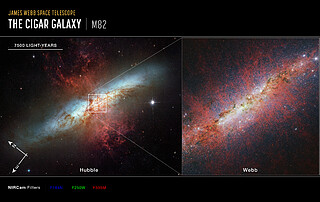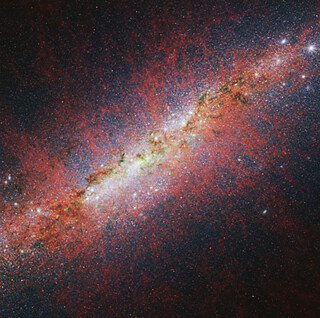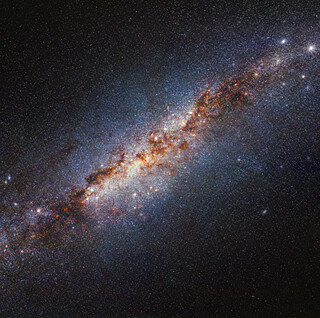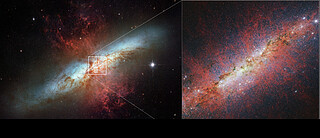weic2410 — Science Release
Webb probes an extreme starburst galaxy
Amid a galaxy teeming with new and young stars lies an intricate substructure
3 April 2024
The NASA/ESA/CSA James Webb Space Telescope has set its sights on the starburst galaxy Messier 82 (M82), a small but mighty environment that features rapid star formation. By looking closer with Webb’s sensitive infrared capabilities, a team of scientists is getting to the very core of the galaxy, gaining a better understanding of how it is forming stars and how this extreme activity is affecting the galaxy as a whole.
An international team of astronomers has used the NASA/ESA/CSA James Webb Space Telescope to survey the starburst galaxy Messier 82 (M82). Located 12 million light-years away in the constellation Ursa Major, this galaxy is relatively compact in size but hosts a frenzy of star formation activity. For comparison, M82 is sprouting new stars 10 times faster than the Milky Way galaxy.
The team directed Webb’s NIRCam (Near-Infrared Camera) instrument toward the starburst galaxy’s centre, obtaining a closer look at the physical conditions that foster the formation of new stars.
“M82 has garnered a variety of observations over the years because it can be considered as the prototypical starburst galaxy,” said Alberto Bolatto, lead author of the study. “Both Spitzer and Hubble space telescopes have observed this target. With Webb’s size and resolution, we can look at this star-forming galaxy and see all of this beautiful new detail.”
Star formation continues to maintain a sense of mystery because it is shrouded by curtains of dust and gas, creating an obstacle to observing this process. Fortunately, Webb’s ability to peer in the infrared is an asset in navigating these murky conditions. Additionally, these NIRCam images of the very centre of the starburst were obtained using an instrument mode that prevented the very bright source from overwhelming the detector.
While dark brown tendrils of dust are threaded throughout M82’s glowing white core even in this infrared view, Webb’s NIRCam has revealed a level of detail that has historically been obscured. Looking closer toward the centre, small specks depicted in green denote concentrated areas of iron, most of which are supernova remnants. Small patches that appear red signify regions where molecular hydrogen is being lit up by the radiation from a nearby young star.
“This image shows the power of Webb,” said Rebecca Levy, second author of the study, at the University of Arizona in Tucson. “Every single white dot in this image is either a star or a star cluster. We can start to distinguish all of these tiny point sources, which enables us to acquire an accurate count of all the star clusters in this galaxy.”
Looking at M82 in slightly longer infrared wavelengths, clumpy tendrils represented in red can be seen extending above and below the plane of the galaxy. These gaseous streamers are a galactic wind rushing out from the core of the starburst.
One area of focus for this research team was understanding how this galactic wind, which is caused by the rapid rate of star formation and subsequent supernovae, is being launched and influencing its surrounding environment. By resolving a central section of M82, scientists have been able to examine where the wind originates, and gain insight into how hot and cold components interact within the wind.
Webb’s NIRCam instrument was well suited to tracing the structure of the galactic wind via emission from sooty chemical molecules known as polycyclic aromatic hydrocarbons (PAHs). PAHs can be considered as very small dust grains that survive in cooler temperatures but are destroyed in hot conditions.
Much to the team’s surprise, Webb’s view of the PAH emission highlights the galactic wind’s fine structure — an aspect previously unknown. Depicted as red filaments, the emission extends away from the central region where the heart of star formation is located. Another unanticipated find was the similarity between the structure of the PAH emission and that of the hot, ionised gas.
“It was unexpected to see the PAH emission resemble ionised gas,” said Bolatto. “PAHs are not supposed to live very long when exposed to such a strong radiation field, so perhaps they are being replenished all the time. It challenges our theories and shows us that further investigation is required.”
Webb’s observations of M82 in near-infrared light also spur further questions about star formation, some of which the team hopes to answer with additional data gathered with Webb, including that of another starburst galaxy. Two other papers from this team characterising the stellar clusters and correlations among wind components of M82 are almost finalised.
In the near future, the team will have spectroscopic observations of M82 from Webb ready for their analysis, as well as complementary large-scale images of the galaxy and its wind. Spectral data will help astronomers determine accurate ages for the star clusters and provide a sense of how long each phase of star formation lasts in a starburst galaxy environment. On a broader scale, inspecting the activity in galaxies like M82 can deepen astronomers’ understanding of the early Universe.
“With these amazing Webb images, and our upcoming spectra, we can study how exactly the strong winds and shock fronts from young stars and supernovae can remove the very gas and dust from which new stars are forming,” said Torsten Böker of the European Space Agency, a co-author of the study. “A detailed understanding of this ‘feedback’ cycle is important for theories of how the early Universe evolved, because compact starbursts such as the one in M82 were very common at high redshift.”
These findings have been accepted for publication in The Astrophysical Journal.
More information
Webb is the largest, most powerful telescope ever launched into space. Under an international collaboration agreement, ESA provided the telescope’s launch service, using the Ariane 5 launch vehicle. Working with partners, ESA was responsible for the development and qualification of Ariane 5 adaptations for the Webb mission and for the procurement of the launch service by Arianespace. ESA also provided the workhorse spectrograph NIRSpec and 50% of the mid-infrared instrument MIRI, which was designed and built by a consortium of nationally funded European Institutes (The MIRI European Consortium) in partnership with JPL and the University of Arizona.
Webb is an international partnership between NASA, ESA and the Canadian Space Agency (CSA).
Image Credit: NASA, ESA, CSA, STScI, A. Bolatto (UMD)
Links
Contacts
Bethany Downer
ESA/Webb Chief Science Communications Officer
Email: [email protected]
Ninja Menning
ESA Newsroom and Media Relations Office
Email: [email protected]
About the Release
| Release No.: | weic2410 | |
|---|---|---|










